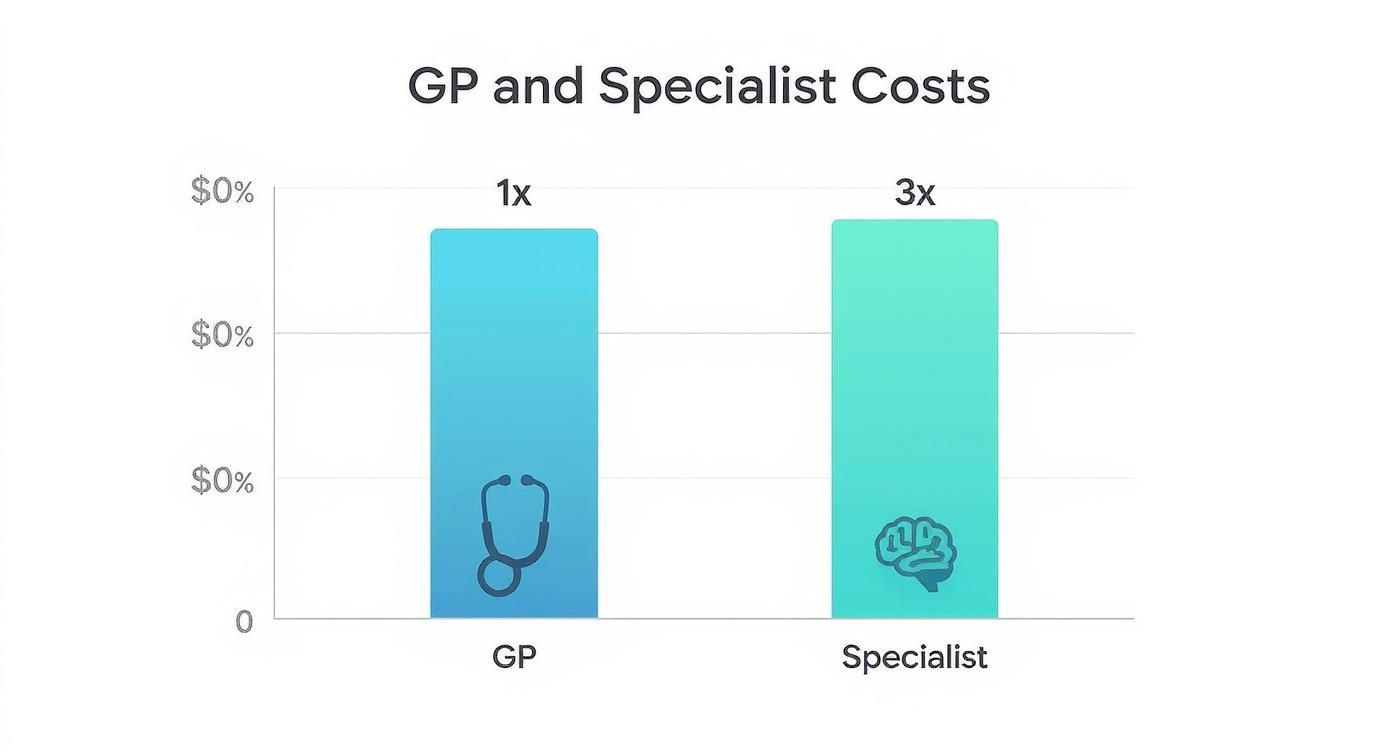For the globally mobile professional, understanding healthcare expenditure is not merely prudent—it is a fundamental component of sound financial management. The ultimate cost of a doctor visit is highly variable, contingent upon your geographic location, the specific nature of the care required, and the intricate details of your private medical insurance. Consider it less a fixed commodity and more a bespoke service, where the final invoice is an aggregate of several distinct components.
Decoding Private Doctor Visit Costs Worldwide

As a high-net-worth individual accustomed to operating across international assignments, you demand clarity and value in all your dealings. Your healthcare should be no exception. However, the costs for premier private medical care are seldom straightforward, fluctuating dramatically between major financial hubs such as New York, London, and Singapore.
This guide is engineered to provide that essential clarity. We will dissect the core components that constitute your medical invoice, moving beyond the base consultation fee to illuminate the ancillary charges that frequently appear. Mastering this structure is the foundational step toward commanding your healthcare expenditures.
The Anatomy of a Medical Bill
The advertised price for a consultation is merely the entry point. Several other variables contribute to the final invoice, each representing a specific service or resource utilized during your appointment.
To strategically manage these costs, it is imperative to understand precisely what you are procuring. The service extends well beyond the physician's time.
The final invoice for a private medical visit is rarely a single line item; it is a composite of several distinct charges. Here is a precise breakdown of what to anticipate.
Key Factors That Determine Your Doctor Visit Bill
| Cost Component | Description | Typical Impact on Final Bill |
|---|---|---|
| Consultation Fee | The foundational charge for the physician's time and professional expertise. This is the most predictable element of the bill. | Moderate |
| Facility Fees | A charge levied by the clinic or hospital for the use of their premises, equipment, and administrative support. This can be an unexpected cost. | Low to Significant |
| Diagnostic Tests | Any laboratory work (e.g., blood panels, urinalysis) or initial imaging (e.g., X-rays, ultrasounds) conducted during your visit. These are billed separately. | Moderate to High |
| Medical Supplies | Itemized charges for consumables used during your appointment, from sterile gloves and syringes to specialized bandages. | Low |
Understanding these individual cost centers transforms a potentially confusing bill into a clear, itemized statement. It empowers you to discern exactly what you are paying for and to pose incisive questions when necessary.
Global Cost Trends and Considerations
The prevailing reality is that healthcare costs are escalating, particularly in the high-income nations where premier medical services are concentrated. The price of a standard doctor's visit has risen, making meticulous financial planning a necessity.
Consider the United States, for instance. According to the Peterson-KFF Health System Tracker, the average cost for a standard new patient office visit was $201 in 2021. For an individual without robust insurance, out-of-pocket expenses can be substantially higher, with certain specialist consultations readily exceeding $300. You can explore more about global healthcare expenses to see how different countries compare.
This trend underscores the critical importance of a comprehensive International Private Medical Insurance (IPMI) plan. A well-structured policy serves as a vital financial shield, safeguarding your assets while ensuring access to top-tier care, irrespective of your professional location. This is the foundational knowledge required to navigate your healthcare journey with confidence and authority.
The Financial Divide Between GPs and Specialists
When navigating private healthcare internationally, one of the most immediate observations is the stark cost differential between consulting a General Practitioner (GP) and a specialist. This is not a minor price increment; it represents an entirely different financial stratum.
Your GP is your trusted primary point of contact for routine care and initial diagnosis. A specialist, conversely, is the expert engaged when a specific issue requires deep, focused expertise. This distinction is not merely functional—it has profound financial implications.
Understanding this financial divide is critical for managing your healthcare budget as an expatriate. When your GP refers you to a cardiologist or a neurologist, that referral signals an imminent and significant escalation in projected costs.
The Economics Behind Specialist Premiums
What accounts for this significant price disparity? The higher cost of a specialist consultation is a direct reflection of the immense investment required to attain that level of expertise. It is a function of supply, demand, and the inherent value of specialized knowledge.
The pathway to becoming a specialist is considerably longer and more rigorous than that for a GP. This demanding journey creates several key cost drivers that ultimately shape the fee structure:
- Advanced Training and Education: Following medical school, specialists dedicate an additional three to seven years to intensive, focused training in residencies and fellowships. This represents years of deferred earning potential and a substantial educational investment that must be recouped.
- Specialized Equipment: Fields such as dermatology, ophthalmology, and cardiology rely on exceptionally sophisticated and expensive technology for diagnosis and treatment. The capital, maintenance, and operational costs of this equipment are factored into their fees.
- Higher Professional Liability: Specialists manage complex, high-stakes medical conditions. Consequently, their malpractice and professional liability insurance premiums are significantly higher. This is a major operational cost that is passed on to patients.
- Greater Diagnostic Complexity: A specialist is consulted to resolve a medical puzzle that a generalist cannot. Their consultations are often longer, more intensive, and demand greater cognitive effort, thereby justifying a higher fee for their time and intellectual capital.
In aggregate, it becomes clear why specialist doctor visits cost anywhere from two to five times more than a standard GP appointment.
A Practical Cost Comparison
Let us translate this into real-world scenarios. First, consider a routine annual wellness examination with your GP. It is proactive, focused on preventive care, and typically follows a predictable protocol.
Now, imagine a second scenario: your GP refers you to a neurologist to investigate persistent headaches. This visit is diagnostically driven. It requires a detailed exploration of your symptoms, a comprehensive neurological examination, and potentially a plan for advanced imaging such as an MRI.
A standard GP consultation might be priced between $150 and $300 in a major global city. In contrast, an initial consultation with that neurologist could easily range from $400 to $750 or more—and this is before a single diagnostic test is ordered.
This stark difference highlights why one must anticipate a cost shift the moment a specialist referral is made. You are transitioning from a routine healthcare expense to a significant, targeted investment in specialized medical intelligence.
For professionals managing their finances, understanding this escalation is key to avoiding financial surprise and ensuring your IPMI plan is structured to accommodate these higher-tier expenses. A degree of foresight ensures that your health and financial strategies remain perfectly aligned, regardless of the level of care required.
Comparing Healthcare Costs In Key Global Hubs
Your location will dramatically shape your healthcare expenditures. A private doctor’s visit in New York City is an entirely different financial event than one in Dubai or Singapore. For any globally mobile professional, understanding these regional price structures is not merely academic—it is a core component of managing personal finance and risk.
These cost differentials are not arbitrary; they are intrinsically linked to local healthcare models. The United States, with its predominantly private, insurance-driven system, consistently exhibits the highest costs globally. In contrast, cities like London and Singapore operate hybrid systems, where a robust public option coexists with a premium private sector, creating a distinct pricing environment.
This analysis provides the financial intelligence you need. We will look beyond basic consultation fees to examine the real costs, including common diagnostic tests, in four major financial centers. The objective is to help you anticipate and manage the doctor visits cost with precision.
New York City: A Premium Market
In New York, the private healthcare market is the benchmark for high costs. The system is characterized by high operational expenses, substantial liability insurance costs for physicians, and a billing culture that itemizes every service provided.
An initial consultation with a top-tier General Practitioner (GP) in a private Manhattan clinic will typically range from $250 to $500. Should you require a leading specialist, such as a cardiologist or dermatologist, that fee escalates significantly, often starting at $500 and easily exceeding $1,000 for a first visit.
Diagnostic services add another layer of expense:
- Comprehensive Blood Panel: Expect an invoice between $300 and $700.
- MRI Scan: An MRI of a joint, for example, can range from $1,500 to $4,000, depending on the facility.
These figures make it unequivocally clear why a top-tier International Private Medical Insurance (IPMI) plan is not a luxury in NYC; it is a financial necessity.
London: A Tale of Two Tiers
London’s healthcare landscape presents a fascinating interplay between the public National Health Service (NHS) and the prestigious private sector, famously centered around Harley Street. While the NHS provides high-quality care, extended waiting times for specialist appointments often compel professionals to the private market for expediency and convenience.
This dual system fosters a competitive, yet still premium, private environment. A private GP consultation generally costs between £150 and £300 (approximately $190 to $380). A first-time appointment with a private specialist will typically fall within the £250 to £500 range (around $315 to $630).
Diagnostic costs in London's private sector are more contained than in New York:
- Comprehensive Blood Panel: Typically costs £150 to £400 (about $190 to $500).
- MRI Scan: Private MRI scans are generally priced between £700 and £1,500 (around $880 to $1,890).
The chart below illustrates the typical cost escalation from a GP to a specialist—a key factor to incorporate into your healthcare budgeting.

As depicted, a specialist visit represents a major financial step up, often costing three times as much as a GP consultation. This ratio remains remarkably consistent across most major global hubs.
Estimated Private Doctor Visit Costs In Major Global Cities
To provide a clearer at-a-glance comparison, we have compiled a table outlining typical costs in these key cities.
| City | Average GP Consultation Cost (USD) | Average Specialist Consultation Cost (USD) | Notes on Local Billing Practices |
|---|---|---|---|
| New York City | $250 – $500 | $500 – $1,000+ | Itemized billing is standard; facility fees often separate. |
| London | $190 – $380 | $315 – $630 | "Package" prices for diagnostics are common. |
| Singapore | $75 – $150 | $135 – $260 | Costs are transparent; often include basic medications. |
| Dubai | $95 – $165 | $135 – $245 | Pricing is regulated; insurance direct billing is widespread. |
This table underscores the extent to which location dictates cost, with New York standing out as a significant outlier.
Singapore and Dubai: Modern Hubs with Managed Costs
Singapore and Dubai have meticulously engineered world-class healthcare systems tailored to an international clientele. Both boast state-of-the-art facilities and a vibrant private sector, but with pricing structures that are far more regulated and transparent than those in the West. The healthcare culture here is quite distinct from European models, such as the system detailed in our guide on health insurance for expatriates in Switzerland, which offers another unique framework.
In Singapore, a private GP visit at a high-end clinic like Raffles Medical will cost between SGD 100 and SGD 200 (about $75 to $150). A specialist appointment is usually between SGD 180 and SGD 350 (roughly $135 to $260).
Dubai is similarly competitive. A GP visit in a premium facility runs about AED 350 to AED 600 (around $95 to $165), while a specialist consultation ranges from AED 500 to AED 900 (about $135 to $245).
In these hubs, the key financial variable is often not the initial consultation but the subsequent follow-up care. While the first visit is more affordable, the total cost of treatment can escalate quickly depending on the required diagnostics and treatment plans.
This overview of global healthcare costs reveals a simple truth: your location is one of the most significant drivers of your annual medical spending. By understanding these regional benchmarks, you can make more informed decisions about your IPMI coverage and proactively manage your financial exposure.
How to Read and Understand Your Medical Bill

Receiving a medical bill from a private international clinic can feel akin to deciphering a complex financial instrument. It is far more than a simple receipt. Instead, you will find a granular breakdown of every supply used and every minute of a professional's time. For an individual accustomed to financial transparency, mastering these documents is essential for maintaining control.
Consider it analogous to the detailed folio from a luxury hotel. Every service, from the initial consultation down to the smallest consumable, is itemized. While initially appearing overwhelming, this detail is your most effective tool for ensuring accuracy. It empowers you to analyze your doctor visits cost with a critical eye, identify discrepancies, and obtain clarity before any funds are transferred.
Dissecting Common Charges Beyond the Consultation
The consultation fee is merely the headline item. The supporting charges truly define the final bill. Private clinics in major global hubs operate as sophisticated businesses, and their invoices reflect this reality. A typical bill will delineate charges into several distinct categories, each warranting close scrutiny.
You will observe line items that extend well beyond the physician’s time. Knowing what these represent and having the confidence to question them is fundamental to managing your healthcare expenditures abroad.
Here are the most common charges to anticipate:
- Facility Fees: This is essentially a charge for the use of the clinic's physical space, advanced equipment, and administrative staff. It is almost always billed separately from the doctor's professional fee and can vary widely based on the clinic’s prestige and location.
- Medical Supplies: It is standard practice to see itemized costs for all consumables, from sterile gloves and syringes to bandages and antiseptic solutions. While these charges are individually small, their aggregate can be significant.
- Laboratory Services: Any blood work, urinalysis, or other specimens sent for testing will generate their own invoice. These services are often outsourced to a partner laboratory—a separate business entity—which explains why they frequently appear as a separate charge.
- Imaging Services: Similar to lab work, any X-rays, ultrasounds, or MRIs will be billed as a distinct line item. This covers the use of capital-intensive machinery and the professional time of a radiologist to interpret the results.
Identifying and Addressing Billing Discrepancies
Billing errors are more common than one might expect, often stemming from administrative oversight, incorrect coding, or system glitches. Reviewing your invoice with precision is not an act of distrust; it is an exercise in due diligence. The first step is to methodically match the itemized bill against the services you recall receiving.
A frequent error is the duplication of charges for the same test or service. Another common issue is the application of an incorrect billing code, which can dramatically alter the cost of a procedure. Your attention to detail here can yield tangible savings.
If you identify a charge that appears incorrect or that you do not understand, the first course of action is to contact the clinic's billing department directly. Request a "Statement of Services" for a more thorough explanation of the charges. Maintain a professional and inquisitive tone; request clarification on specific line items rather than making broad accusations. This approach invariably leads to the most efficient and positive resolution.
The Role of Your Insurance Policy
Understanding the clinic's bill is only one part of the equation. The other is knowing precisely how your International Private Medical Insurance (IPMI) policy will adjudicate it. Your policy's structure—particularly its deductibles and excesses—dictates your final out-of-pocket liability. You can find an essential deep-dive into the nuances of excesses and deductibles in our guide on the fine print of insurance policies.
Before settling any invoice, await the receipt of an Explanation of Benefits (EOB) from your insurer. This document is your financial Rosetta Stone. It details which charges were covered, the amount the insurer paid, and the exact balance for which you are responsible. It is the definitive tool for reconciling the clinic's invoice with your policy's contractual obligations, ensuring you never pay more than your share.
For a more detailed analysis over time, you might even explore tools that help you extract data from invoices to track specific charges and payments.
Making Your International Health Insurance Work for You
Your International Private Medical Insurance (IPMI) should be viewed as more than a safety net—it is the single most critical financial instrument you possess for managing healthcare costs on a global scale. To leverage its full potential, you must shift from a reactive posture on medical bills to a proactive strategy regarding your coverage.
This is not about simply carrying an insurance card. It is about understanding the mechanics of your policy. Your IPMI is not a blank cheque; it is a sophisticated contract with specific rules of engagement. Mastering these rules is the key to protecting both your health and your financial portfolio, regardless of your location.
The Three Terms That Control Your Wallet
At the core of every IPMI plan are three concepts that directly dictate your out-of-pocket expenditure for a doctor visit: deductibles, co-payments, and annual limits. They may appear as fine print, but they are the primary levers that control your spending. A firm grasp of these is non-negotiable for anyone serious about managing a global healthcare budget.
- Deductibles: This is the fixed amount you must pay yourself before your insurance company begins to contribute. If your plan has a $1,000 deductible, you are liable for the first thousand dollars of medical expenses each policy year.
- Co-payments (or Co-insurance): Even after your deductible is met, you will likely share a portion of the cost. A co-payment is a fixed fee, such as $50 for a specialist visit. Co-insurance is a percentage-based split—for instance, you pay 20% of the bill while your insurer covers the remaining 80%.
- Annual Limits: This represents the absolute maximum your insurer will pay out in a policy year. High-end IPMI plans often feature very high limits, but it is essential to verify the specifics, especially for sub-limits on outpatient care or complex diagnostics.
Understanding the interplay of these three elements is critical. A policy with a low monthly premium often comes with a high deductible, meaning your initial costs will be significant. We deconstruct these further in our guide to expat medical insurance policy terms.
The In-Network vs. Out-of-Network Financial Cliff
One of the most significant financial decisions you will make when seeking care is whether to consult a physician who is "in-network" or "out-of-network." The cost differential is not marginal—it is a chasm.
In-network providers have a contractual agreement with your insurance company. This agreement provides them access to pre-negotiated, discounted rates for their services, often 20-40% lower than their standard fees. By remaining within the network, you benefit from these preferential rates and your insurer covers a larger portion of the bill.
Step outside that network, and all such arrangements are void. The provider can charge their full, undiscounted rate, and your insurance plan will cover a much smaller percentage—if it covers it at all. The financial impact can be substantial.
For example, you see an in-network specialist. After your deductible, your co-payment might be $50. That same visit with an out-of-network provider could be based on their full $600 fee, and your plan might only cover 50% or less. You would be left with a liability of $300 or more.
Pre-Authorization: Your Financial Green Light
For any non-emergency procedure—such as consulting a specialist, scheduling a surgery, or undergoing an MRI—your insurer will almost certainly require pre-authorization. This is a mandatory checkpoint. It is the process by which your insurer confirms that the proposed treatment is medically necessary and covered under the terms of your plan.
Bypassing this step is one of the most financially detrimental errors you can make. Insurers are fully within their rights to deny the claim entirely, leaving you responsible for the full invoice.
The process is straightforward: your physician's office submits the treatment proposal to your insurer for approval. Always treat this as a non-negotiable part of the process. Pre-authorization is your financial green light, protecting you from unexpected five-figure liabilities down the line.
Proactive Strategies for Managing Your Healthcare Costs
Navigating doctor visit costs as a global citizen is not about compromising on premier care—it is about intelligent, informed financial planning. To maintain control, you must transition from a reactive to a proactive stance on medical expenditures. This involves anticipating costs, utilizing your resources judiciously, and communicating with clarity at every stage.
Adopting this mindset transforms your relationship with healthcare, shifting it from a position of uncertainty to one of command. The objective is simple: secure world-class medical attention without ever jeopardizing your personal financial strategy. These steps will empower you to manage your healthcare investments with genuine confidence.
Key Actions for Financial Control
The single most effective method for managing the doctor visits cost is to take specific, preemptive actions before, during, and after your appointment. Small, strategic moves here can yield significant financial clarity and savings.
-
Request Cost Estimates: Before committing to any non-emergency consultation or procedure, engage with the clinic’s billing department. Request a written estimate that itemizes anticipated charges, including the consultation, standard facility fees, and any probable diagnostic tests.
-
Utilize Insurer Tools: Most top-tier IPMI providers offer sophisticated online portals or concierge services. Use them. These are your primary tools for identifying in-network specialists, verifying the status of your deductible, and understanding the specific coverage limits of your plan.
-
Maintain Open Communication: Foster a clear line of dialogue with both your clinic and your insurance advisor. Ensure any required pre-authorizations are secured for specialist visits and obtain a firm understanding of your precise out-of-pocket responsibility.
A proactive approach is predicated on one principle: transparency. Never hesitate to request financial clarification from a clinic. In the world of premier international healthcare, this is a standard and expected business practice.
Beyond your regular appointments, you might also consider exploring private at-home testing options to gain deeper insights into your health baseline. Such proactive measures facilitate smarter decisions and can identify potential issues early, aligning perfectly with a strategy of intelligent, long-term health management.
Frequently Asked Questions
When engaging with premier international healthcare, it is natural to have questions regarding the financial aspects. I receive these inquiries frequently from global professionals such as yourself.
Here are direct, pragmatic answers to the most common questions. Consider this a concise reference for managing your doctor visit costs with greater clarity and less ambiguity.
How Can I Get an Accurate Cost Estimate Before a Visit?
You must be direct and proactive. Do not wait for the invoice to arrive. Before scheduling the appointment, contact the clinic's international patient or billing department.
Request a detailed, written breakdown of all anticipated charges. This should not be limited to the doctor's time; it must include the physician's consultation fee, any standard facility fees, and the cost of likely initial tests. If you provide your IPMI details, they can often furnish a more precise out-of-pocket estimate based on the rates they have pre-negotiated with your insurer.
Will My IPMI Fully Cover a Specialist Visit?
That is entirely contingent on the specific terms of your policy. High-end IPMI plans typically provide excellent specialist benefits, but you must verify the details of your deductibles, co-payments, and annual limits.
Some policies will not provide full coverage unless you have a referral from a GP. Furthermore, consulting an "out-of-network" specialist is a near-certain way to increase your personal liability. Before any visit, confirm every detail with your insurance advisor to eliminate the possibility of unwelcome financial surprises.
The cardinal rule is this: never assume coverage. A five-minute conversation with your insurance advisor can prevent thousands of dollars in unexpected costs and ensure a seamless claims process.
Are Prescription Medications Part of the Doctor Visits Cost?
No, they are entirely separate line items. The consultation fee compensates the physician for their expertise and time during your appointment.
You will pay for any prescribed medication separately at the pharmacy. Your IPMI plan will have a distinct set of benefits for pharmacy services, which may include its own co-pay or deductible. To obtain a complete financial picture, you must understand both your outpatient benefits and your pharmacy benefits.
Attempting to navigate the complexities of international medical insurance independently is an inefficient use of your valuable time. Riviera Expat specializes exclusively in securing top-tier IPMI plans for high-net-worth professionals in global financial hubs. Allow our experts to provide the clarity and control you require. Explore your IPMI options with Riviera Expat.

